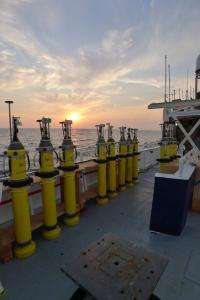Synchronized probes explore Bermuda Triangle's swirling vortices

(Phys.org) -- Some might say that University of Washington oceanographers did well to only lose one of 21 underwater probes, given that they were deployed near the notorious Bermuda Triangle, where boats and airplanes have been known to disappear without a trace.
The scientists chose the location to research its swirling whirlpools via a pioneering experiment that repeatedly sent the probes deep into the ocean and back to the surface in unison.
“Nothing like this has ever been done,” said Tom Sanford, an oceanographer at the UW’s Applied Physics Laboratory. “It will be the paradigm for future experiments.”
Typically, oceanographers may deploy an instrument in one place and then travel by boat to another spot to launch it again.
“You make observations that are a few kilometers apart but also a few hours apart. During that time, the tides change things and the wind blows. Yet you make measurements and treat them as if there was just a spatial change and not a temporal one,” Sanford said.
His group invented the velocity sensors that were added to commercial autonomous profilers, so called because they take measurements as they travel vertically through the water creating a profile of the water’s characteristics. They also changed the software to synchronize the path of the profilers, or underwater probes, which were programmed to dive to a specific depth and rise to the surface at scheduled intervals. When they reached the surface, they communicated their GPS positions and a small set of other data via satellites.
.jpg)
During the deployment, the profilers traveled within about a minute of each other.
The new velocity sensor on the profilers picked up electric current in the ocean to track the velocity of moving water. The sensors measure electric current generated when ocean water flows through the Earth’s magnetic field. The higher the voltage the faster the water is moving.
The profilers were deployed during a three-week period last summer in the Sargasso Sea, which encompasses the so-called Bermuda Triangle, and placed in arrays covering areas of around 10 kilometers in diameter, a little more than 6 miles.
While Sanford deployed the 21 profilers, researchers from UW and many other organizations used a number of other technologies at the same time to collect a vast amount of data. The other technologies included four gliders, 42 drifters, three equipment-towing boats and an airplane. The equipment gathered data about ocean characteristics such as temperature, salinity and velocity to describe flow structure and mixing.
The researchers built such a sophisticated expedition because of the subject they are studying: internal waves and whirlpools, known as vortices.
“What’s mysterious are these vortices that exist due to various processes and float around for a long life, banging into each other. They may be responsible for ocean mixing,” Sanford said.
A vortex is a swirl of water that can be created in several ways, including water being pushed between land masses and then released into the open ocean. The subsurface features are hard to measure, Sanford said, because when they pass an underwater sensor they appear to be waves. Only by locating other sensors nearby at the same moment can researchers identify that movement as a swirl and not a wave.
Scientists are interested in ocean mixing in part so they can learn more about how climate change might affect the deep ocean. Researchers know that the atmosphere, tides, sunlight, and surface and internal waves affect the temperature of the top few meters of the ocean. They also have some understanding of large-scale eddies and ocean dynamics, visible via satellite images, that cause broader ocean mixing.
“What we have difficulty doing is identifying and tracking some of the smaller-scale features, particularly well below the surface. We know they’re there but we don’t know enough about their role in maintaining the ocean structure,” Sanford said. Those features, like deep waves and vortices, mix upper water, which is warmer and has more carbon dioxide, deeper into the ocean.
Now that the expedition is complete, the researchers have started analyzing the data. Their initial graphs simply plot the raw data, with a squiggly vertical red line depicting the upward trajectory of each profiler and a blue line their downward paths. But they hope to be able to draw conclusions by more closely studying the data.
Provided by University of Washington

















